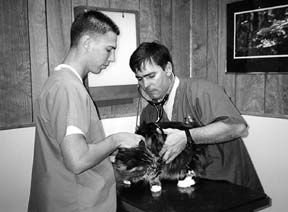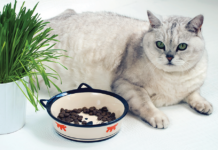

288
The feline pancreas is a slender, pink, v-shaped strip of tissue tucked snugly within the right-hand side of your cats abdomen, at a junction between her stomach and her duodenum – the beginning portion of her intestine. Its a relatively small organ, typically weighing a half-pound or so.
Despite the organs modest size, its multifaceted task is mighty. Indeed, your cats good health depends on a properly functioning pancreas. Serious pancreatic injury or disease can imperil the animals life, and total loss of pancreatic function would kill her. Either can occur as the result of pancreatitis, a traumatic inflammation of this vital organ.
Normal Functions
To understand the grave risk associated with pancreatitis, one must know a bit about how this glandular organ operates. Essentially, the pancreas plays two vastly important roles, one of which is the endocrine function. Although comprising only about two percent of total pancreatic mass, endocrine tissue is made up of small clusters of cells called islets of Langerhans. These cells produce insulin and glucagon, two hormones needed to control levels of blood sugar. The most common disorder of the endocrine pancreas is diabetes mellitus.
The other role that the pancreas plays is the exocrine function, the major activity of which is to produce and secrete a potent liquid rich in chemicals (enzymes) that eventually pass out of the pancreas and into the small intestine to assist in the digestion of fats, proteins and carbohydrates.
A Grim Scenario
If those digestive enzymes were to start working while still inside the pancreas, says Richard Goldstein, DVM, a lecturer in clinical sciences at Cornell University College of Veterinary Medicine, they would begin feeding on the organ itself, since it is also made of fat, protein and carbohydrate. The miracle of nature is that the enzymes are very protected.
While in the pancreas, explains Dr. Goldstein, the digestive chemicals -these nasty enzymes, as he calls them – are sequestered in tiny droplets that prevent their coming into direct contact with pancreatic tissue. Moreover, he says, the enzymes are biochemically programmed to remain inactive until after they have been secreted and have traveled via the pancreatic duct into the small intestine.
The process of enzyme secretion has several stimuli, says Dr. Goldstein. It may begin with the animals hunger – merely thinking of food. Or it can be the process of eating and swallowing food and the fact that the stomach is being filled.
If the digestive enzymes were to become activated while still in the pancreas, death could occur within a very short time, he notes. Its an amazing phenomenon that things usually dont go wrong, Dr. Goldstein remarks. When things do go wrong, however, and the enzymes start digesting the pancreatic tissue, weve got pancreatitis.
A Mysterious Disorder
Although it is the most common disorder of the feline exocrine pancreas, studies have indicated that pancreatitis occurs in fewer than two percent of the general cat population. Its probably more prevalent, says Dr. Goldstein, but the problem is that there is no 100 percent, perfect test for pancreatitis. But I would think that the prevalence is a lot higher than we actually know. Cats of both sexes and of all ages and breeds appear to be similarly vulnerable.
The causes of pancreatitis also remain unknown. Something – perhaps a defect in an animals natural defense mechanisms – triggers the disease and results in digestion of the pancreatic tissue, says Dr. Goldstein. Some people believe it can be caused by too much fat in the diet or by ingestion of insecticides or other toxins.
In some cases, physical trauma – being hit by a car or falling from a great height – have been associated with cases of the disease. Various infectious disorders, such as feline herpesvirus, have been cited as possible causes of pancreatitis, as have such factors as adverse drug reactions, inflammatory bowel disease and parasitic infection.
In Dr. Goldsteins opinion the most common cause is probably a lack of oxygen (hypoxia) in the pancreas. This can result from an accident, from anemia or from another disease process, he says. But we usually dont know what the specific cause is.
Signs, Diagnosis, Treatment
The most common clinical signs of feline pancreatitis include lethargy, loss of appetite, dehydration and low body temperature. Cats with this disease typically dont vomit, and they typically do not have abdominal pain, says Dr. Goldstein. They just lie there like any other sick animal – theyre lethargic and they dont want to eat.
Cats with suspected pancreatitis do seem to have high levels of abdominal fluid, he adds, and they tend to be jaundiced – a yellowish tinge to their skin, gums, the whites of their eyes and the tissue inside their mouths. But these signs, he observes, are common in other disorders as well, such as liver disease.
So pancreatitis is very hard to pick up in the examination room, says Dr. Goldstein. But you always have to have a suspicion of it. If you dont, youll never be able to diagnose it and move forward with treatment.
To be on the safe side, he advises, owners should seek veterinary counsel if a cat with a typically healthy appetite refuses to eat – even for just a day. The veterinarian may not do a lot of tests at first, Dr. Goldstein says, but if the cat continues to be lethargic and doesnt resume eating within a day or two, this will be taken very seriously.
The standard diagnostic procedure, says Dr. Goldstein, will involve a medical history of the animal, thorough physical examination, bloodwork and ultrasound.
Radiography tends to be of little value, he notes, since pancreatic abnormalities – indeed, the organ itself – are not readily perceptible on X-rays. But X-rays are sometimes useful in ruling out other disorders, such as an intestinal obstruction, which can have signs identical to those of pancreatitis. As for ultrasound, he says: Although ultrasound is still not very good for spotting pancreatitis, various studies show that 30 percent to 50 percent of cases that we think are pancreatitis are picked up. So if you think you see it on ultrasound, thats a pretty reliable finding. On the other hand, not seeing it doesnt necessarily mean that its not present.
The only way a sure diagnosis can be made is through a biopsy, he notes, but this involves a surgical or laproscopic procedure that may not be advisable for a seriously ailing, physically debilitated animal.
So in a lot of cases, Dr. Goldstein says, you have to just make the assumption of pancreatitis based on the physical exam, bloodwork and ultrasound – and then you begin treatment. The trouble is that there is no uniformly effective, definitive treatment for feline pancreatitis, either.
Nevertheless, the cat will have to be hospitalized for several days at least, while treatment – such as it is – proceeds and the animals spirits gradually pick up and it resumes its normal eating habits. We cant withhold food because if we do that, the cat is at risk of developing serious liver disease, says Dr. Goldstein. So we will feed the cat – through tubes leading directly into its stomach if necessary. The main goal is to make sure that the cat keeps getting its nutrition.
A Complicated Prognosis
In all cases, Dr. Goldstein says, prognosis is guarded. Pancreatitis can be a fatal disease, he says. The outcome depends not only on severity but also, unfortunately, on finances. How long will the owners allow the cat to be hospitalized, and how long will they go along with intravenous and tube feeding, which is very expensive?
Theres no way to treat feline pancreatitis on an outpatient basis, and 24-hour care can run into thousands of dollars. Pancreatitis is not a good disease to have.


